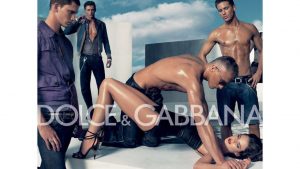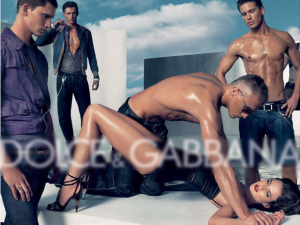
The original image I chose to Culture Jam was an advertisement created by the fashion house Dolce & Gabbana for their Spring 2007 campaign. It features four men and one woman. The four men are not only of a strong physique, and skin shining as if from exertion, their body language shows dominance in their stance and facial expression. The lone female on the other hand is pinned against the ground in a vulnerable position by one of the men, while the other three look on from above. All of the above parties could be described as “white”. Even from just reading this description we can immediately see that this advertisement shows themes of rape, rape culture, consent, hyper-heteronormativity, as well as white male dominance and hypersexualized females in the media and fashion and entertainment industries. The vulnerability of the female’s position under the one male, her hands pinned in an aggressive way, face averted, all suggested a lack of consent and rape culture in the fashion industry. The ratio of men to women also conveys the discourse of how rape in gendered in Western society, women always being painted as the victims and men as the aggressors. The woman in clad in extremely feminine garments as well as high heels, and her pelvis, which seems to be raised in struggle, all convey as sense of hypersexuality. This advertisement also serves as another piece of popular culture that is furthering a white-male dominated, heternormative dialogue, which is still prevalent in Western societies and the media.

My CultureJammed edit of the original Dolce & Gabbana advertisement, shows a very subtle and thought provoking change that addresses what could be considered the most obvious concern regarding the theme of the image. I chose to blur out the text in the advertisement as a play on the “blurred lines” of consent idea. This addresses in the dominant dialogue of consent as optional when it comes to sex, and rape culture being glamorized as such. Just because a woman may be dressed in a very femininely in a way that shows off her body, does not mean that that presentation itself is a substitute for willing verbal consent, as is suggested above. The advertisement may have been aiming to convey the message that the label’s clothing makes a woman desirable, that men will not be able to help themselves when they see you, but it came off as a justification for rape culture. It also conveys that since a woman is dressed in what society would deem a overtly feminine and sexual way, does not in any way speak for a woman’s individual sexuality. A feminine female does not mean heterosexual as much as a strong “manly” male is not inherently heterosexual. This advertisement only serves to promote heternomative discourses, and a white-male dominated societal norm. This advertisement confirms the commonly gendered view of rape, which disqualifies male victims’ experiences as valid. Consent is not optional and the lines regarding it should never be blurred whatever the gender of the victim may be.